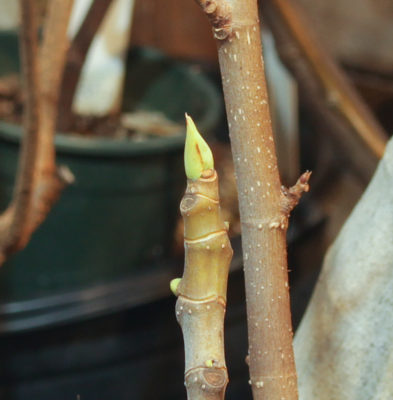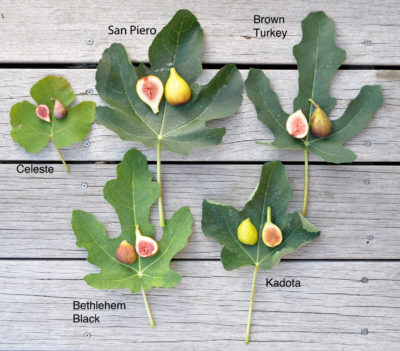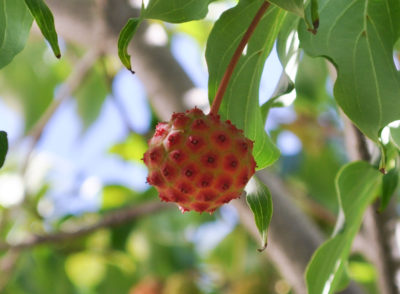MOVING ALONG, INSIDE AND OUT
Figs Awakening
Even in the cool temperature (45 degrees Fahrenheit) and darkness of my basement, the potted figs can feel spring inching onward. Buds at the tips of their stems have turned green and are just waiting for some warmth to burst open. Or, if the plants just sit where they are long enough, the buds will unfurl into leaves and shoots. Which would not be a good thing.
My goal is to keep the plants asleep long enough so that they can be moved outside when they will no longer be threatened by cold temperatures. How much of a threat temperatures pose depends on how much asleep the plants are. Fully dormant, a fig tree tolerates temperatures down into the low 20’s. Even now, as they are just barely awakening, they can probably laugh off temperatures into the mid-20s.
If the buds expand into shoots and leaves, they’ll be burned by any temperature below freezing. And especially so if those new shoots and leaves get started indoors, where warm temperatures and relatively low light makes for overly succulent growth. Bright sunlight, even without freezing temperatures, can then cause damage.
Fig plants that start growing in earnest indoors get presented with two options. The first is to get them to the sunniest window in the coolest room so that growth is more robust, then move them outdoors after any threat of frost has passed — about the same time as tomato transplants get planted out. (Around here, that’s about the third week in May.)
The second option is to move them outdoors as soon as temperatures won’t again fall below the mid-20s. Temperatures below 32 will burn the succulent, new shoots and leaves, but plants will push forth new growth well-adapted to the great outdoors. If an Arctic blast is predicted, with lower that usual temperatures — that is, below about 25 degrees Fahrenheit — the plants need to be moved temporarily to the garage, mudroom, or other convenient shelter.
Different Strokes For Different . . . Figs
A fig’s treatment depends on the variety. Genoa, Excel, and Ronde de Bordeaux are three new varieties that I hope to taste this summer. They’ll get first-class coddling: Moved outside soon, then put into temporary shelter at the slightest hint that damaging temperatures could arrive. I might just put the others outside, and leave them there.
The Kadota fig gets planted, in its pot, right in the ground. Its roots will grow out through all the holes I drilled in the side and bottom of the pot so the plant becomes self-supporting, waterwise, until fall. I’ll plant it out soon, even though once it’s planted, it’s staying put all season long. (I have a backup plant.)
Too Weird To Eat
Moving forward into spring — on into late spring — brings dogwoods into bloom. Blossoms of our native flowering dogwood (Cornus florida) will soon be followed by those of kousa dogwood (C. kousa), and also called Japanese or Korean dogwood), native to east Asia.
The flowers of both species are very small and pretty much green. “Not so!,” you say, thinking back to last spring’s show of large white or pink petals. Those large white or pink things are, in fact, not petals, but bracts, which are modified leaves that, admittedly, serve pretty much the same function as petals, that is, to look pretty, attract pollinators, etc.
Over the years, the spring show from flowering dogwoods has become sparse because of powdery mildew and other diseases. Which is why kousa dogwood, which is disease resistant, has been increasingly planted.
Flowering dogwood can have either pink or white flowers — whoops, I mean bracts. Until recently, kousa dogwood came only in white. But now, breeders at Rutgers University, after decades of work, have introduced Scarlet Fire kousa dogwood, a cold hardy (Zone 5 to 8), disease resistant variety bearing pink bracts.
The flowers of kousa dogwood, whether pink or white bracted, are followed by edible fruits. The round fruits are the size of a quarter, dark pink, and very weird-looking. To me, they look like water (naval) mines, not a very friendly association for a fruit. Their appearance has also been described as that of a sea urchin shell, also not very gustatory. Inside, the flesh is sweetish and mealy, something like a cross between mango and pumpkin — not my two favorite flavors, but even if they were, those dark pink water mines are too off-putting in appearance for me to more than sample them (just so I could report on their flavor).
Still, kousa fruits add to the show from the flowering bracts and the healthy foliage.


I have two Brown Turkey figs that I left outdoors in pots this winter next to the south side of my house, within hardware cloth circles that were filled with leaves. When should I remove them from their protection? (I’m in zone 6B). Also, they have never made figs, though they have robust growth. The year previous I stored them in my shed, wrapped in straw within a black plastic bag and they did fine but still didn’t make any figs. I do not have a basement or “cool room” to store them in unfortunately. Any tips?
Did the stems die back? To how far from ground level? Are they getting 6 or more of direct sunlight daily? Soil that dries out too much (or that gets too wet) can cause developing figs to drop.
Thank you for your reply! The stems have never died back, either when they are stored in the shed or in the leaf circles. I uncovered the figs from the leaf circles last weekend and they looked good, leaf buds but not unfurled yet. They are in a gravel driveway which is on the south side of the house, so they receive plenty of sun. They have just never made any figs, I would even welcome them “dropping” just so I could see some developing!
Do you know what variety the fig is? Can you send any photos of the plant?
I’m also in 6b. I keep my Chicago Hardy fig in the unheated basement (about 55°) with all the windows covered so no sunlight can get in. Each late winter they sprout and then the tender shoots and leaves grow (as much as 8″) before outdoor temps are low enough to put them out. Even putting them out a few days ago I sometimes still need to haul them down through the bulk head overnight to protect them.
Fruit is usually the size of a nickel around the time the first frosts arrive, so I snip the immature off, drag the pots indoors and hope for better luck next season.
Any suggestions would be most welcome.
Those are good choices. For me, Minaj never bore that well so I’m sticking with Titania and Belaruskaja.
I attended the Fort Ticonderoga Garden Symposium where you were a speaker. It was a great talk. I actually went for the pollinator talk then was pleasantly surprised to see you on the roster as I follow your blog. My question is about my Turkey Fig. I have had it for 3 years. I’m in zone 4. It was inside for the winter in a 50 degree low-light room and now has 3 figs and new leaves. I’ve never had figs so early. Should I fertilize? If so, with what? Thanks!!
Fertilizer is probably NOT the plant’s main need. What it does need is abundant light and consistent watering. Too much or too little water and the figlets might fall off. Some figs make fruit on one year old wood (those are the ones you see), some varieties make figs on new wood, and some on both new and old wood. Brow Turkey usually makes figs only on new wood. There is a chance that those figlets developing on old wood will drop no matter what you do. But figs should still form, later in the season, on new wood.
How lucky have you been rooting fig cuttings? I have terrible results. have tried everything. They are very prone to rot.
Used Pumice, Perlite and bottom heat this year, but same results.
Not sure what you’re doing wrong but figs are generally easy to root. Even by dormant cuttings just stuck in the ground where you want a plant. Perhaps too much water in conjunction with too much heat. Not to make you feel bad, but I get close to 100% rooting.